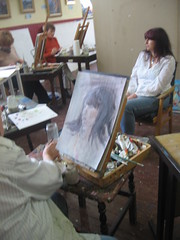I haven’t formally studied singing, but I know several people who have (including my dad, who studied voice throughout my childhood). From what little I do know, diction is a very important aspect of a vocal performance. And what a coincidence, diction (word choice) is very important in writing, too.
In singing, of course, diction means pronunciation and enunciation. When we speak, we often mumble or speak  very rapidly, eliding many sounds, and we can still convey our meaning (or most of it). While singing, you have to put more effort into clearly pronouncing the sounds, or you’ll never get the message across. Singing is a stylized form of speech—you manipulate the length and the pitch to add more meaning and emotion (and beauty).
very rapidly, eliding many sounds, and we can still convey our meaning (or most of it). While singing, you have to put more effort into clearly pronouncing the sounds, or you’ll never get the message across. Singing is a stylized form of speech—you manipulate the length and the pitch to add more meaning and emotion (and beauty).
There are some general rules for “good” diction in singing—some of them more widely-accepted than others. For example, holding out the vowels, not the letters (cf. country-western singing, or many Asian styles) is used in most styles of singing. Yes, some vowels are just dang ugly to hear extended over several beats.
But I’ve also been instructed to roll an ‘r’ (and say “Amerrrica or Amedica the Beautiful”), and to avoid such-and-such a vowel (I hope that accurately portrays the esteem I have for that rule) and always sing X instead.
While slavishly following those rules might make your music teacher happy, some of those rules will make actually make it more difficult for most listeners (we untrained masses) to understand the words and appreciate the music (change the vowel in bid or bud, for example—people won’t know what you’re saying). And highly stylized (or just flat out trying-too-hard) diction in writing can actually make it more difficult for readers to understand what we’re trying to say.
I had this problem with a pretty good book I read recently—sometimes the diction flowed beautifully, using stunning new imagery that was still perfect. Other times, however, it seemed like the diction was trying so hard, the author was right there belting out, “Look at me, I can build a simile!”
But that didn’t get his message across—it made me stop reading and shake my head. What was he trying to say?
While writing, you do have to put more thought and care into choosing your words than you would in dashing off an email or writing a research paper. But like in singing, trying too hard can distance your audience instead of drawing them in with your art and your message.
What do you think? How does diction call attention to itself in writing? How can you tell if you’ve “gone too far”?
Photo by apdk

